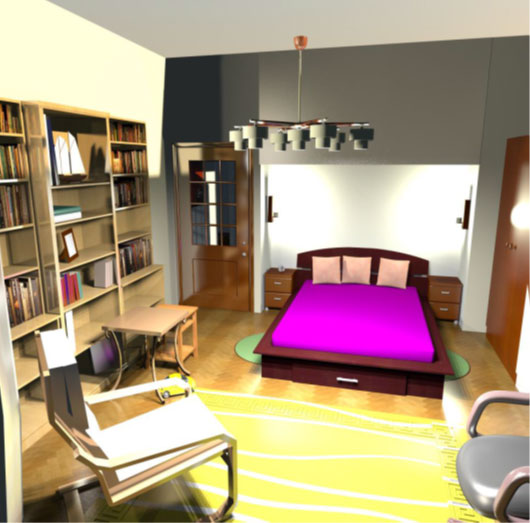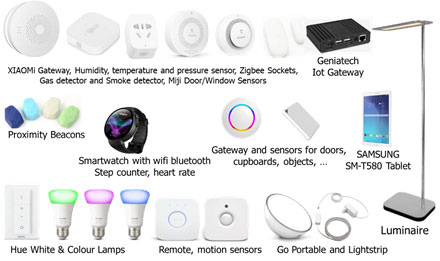by Marco Manca, Parvaneh Parvin, Fabio Paternò, Carmen Santoro and Eleonora Zedda (ISTI-CNR)
The AAL PETAL project has developed a platform for personalising remote assistance of older adults with mild cognitive impairments. The platform is targeted at caregivers without programming knowledge in order to help seniors in their daily activities at home.
ICT technologies have great potential to help prolong the time elderly people can live independently in their preferred environment. However, several barriers exist when it comes to seniors actually using existing technologies: older adults may have different needs and attitudes to younger generations - for example, attitudes towards technology, physical or cognitive limitations, and interests. Furthermore, the needs of elderly people are not static; they are likely to evolve over time depending on variables such as evolving health conditions and preferences. Thus, the personalisation of ICT-based support is a fundamental challenge.
In the AAL PETAL project [L1] at the HIIS Laboratory of CNR-ISTI [L2] we are developing a platform for personalising remote assistance of older adults with mild cognitive impairments, with a particular focus on the support of lighting systems in order to provide orientation over time and in space. This category of users suffers from cognitive issues, such as the tendency to forget tasks/events and/or other issues such as cardiovascular issues, reduced sight, and irregular eating habits, often associated with increased risk of social isolation and depression. The platform monitors the user’s environment and behaviour, and personalises applications and control devices to better support seniors in their daily lives. Thus it exploits smart objects, such as lights, to provide appropriate activation or relaxation stimuli, and it generates alerts and reminders for physical and social activities, orientation over time and space, and sleep quality.
The user or caregiver can set the device to control lights and other digital devices when relevant events occur. In this way it is possible to personalise control of the lights and other digital appliances, to set personalised warning messages to be issued in risky situations, and persuasive messages to encourage healthier habits (e.g., more physical activity). The possible personalisations are expressed in terms of simple trigger-action rules [1, 2, 3]. Triggers represent situations or events that might be useful for caregivers to know: e.g. health/cognitive/emotional status, cognitive/physical/social activity, especially when the caregiver is not present (remote monitoring). The information associated with triggers is derived from various sensors (e.g. motion, proximity, lights, noise, respiration, heart). Actions represent what the technological equipment within the home could do: control appliances (e.g. switch on/off lights, close/open doors, play tv/radio), send reminders, send alarms, provide information about the user’s needs. Personalised rules that can be obtained with this approach include:
- When the user leaves the house and rain is forecast, a phone alert can suggest taking the umbrella;
- A message can be sent to the caregiver when the user leaves home during the night;
- When a caregiver sends a message "where?", an automatic answer provides the user’s location;
- If a user has not done the planned cognitive exercises, a blink of the light acts as a reminder to continue this activity;
- If the user is close to the living room and time is 4 pm, turn on the TV.
We have organised trials in homes with older adults with mild cognitive impairments, distributed across various European countries (Figure 1 shows one home involved in the trials). Figure 2 shows the types of sensors, objects, and devices we use in such trials. Each user has a tablet, and a smartwatch. We have selected a smartwatch that, in addition to detecting physiological parameters such as heart rate and step counter, is able to connect and communicate at the same time through Bluetooth and Wi-Fi. This is exploited to obtain indoor positioning with the support of proximity beacons. For light, we use the GREAT luminaire (designed by Bartenbach, a company involved in the PETAL project), which aims to provide health-stimulating, biorhythm-stabilising, high-quality light for high visual demands, and creates an activating or calming room ambiance with different light scenes. The extremely high light intensity (1000 lx at eye level) of the GREAT luminaire leads to effects comparable with classic light therapy within five hours of use. It compensates missing daylight and provides distributed light within a whole room of about 16 m2. In addition, we use various types of Philips Hue lights to support similar effects in other parts of the home. Other sensors detect gas, smoke, humidity, use of objects, whether windows or doors are open and so on. The platform is also connected with an app developed by Ideable (a Spanish company involved in the PETAL project), which supports serious games for cognitive stimulation in order to allow caregivers to define rules depending on the user’s cognitive and emotional state or depending on the training results.

Figure 1: An example of home involved in the trials.

Figure 2: Sensors and Objects in the Trials.
Supporting this technology is a personalisation platform that includes a middleware (context manager) to gather raw information from the various sensors and convert it into data that can be analysed in terms of logical events and conditions. In this way, when the personalisation rules are created by the user or caregiver, it is possible to detect dynamically when they should be triggered and the consequent actions performed.
References:
[1] G. Ghiani, et al.: “Personalization of Context-dependent Applications through Trigger-Action Rules”, ACM Transactions on Computer-Human Interaction, Vol.24, Issue 2, Article N.14, April 2017.
[2] H. Huang, M. Cakmak: “Supporting mental model accuracy in trigger-action programming”, in Proc. of UbiComp '15. ACM, New York, NY, USA, 215-225. DOI: http://dx.doi.org/10.1145/2750858.2805830
[3] B. Ur, et al.: “Practical trigger-action programming in the smart home”, CHI 2014: 803-812, 2014.
Links:
[L1] http://www.aal-petal.eu/
[L2] https://giove.isti.cnr.it/lab/home
Please contact:
Fabio Paternò, ISTI-CNR, Italy
+39 050 315 3066











